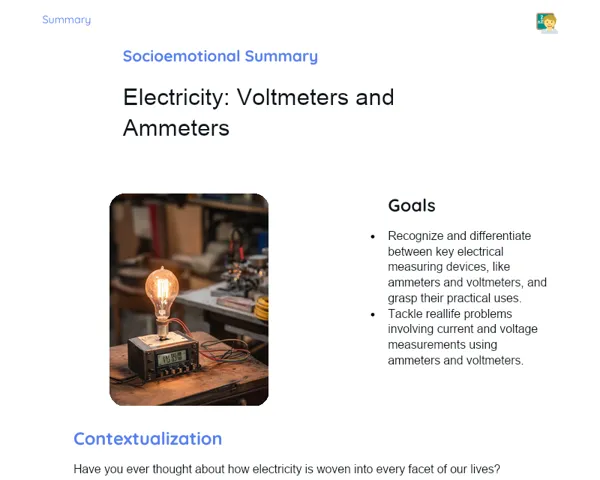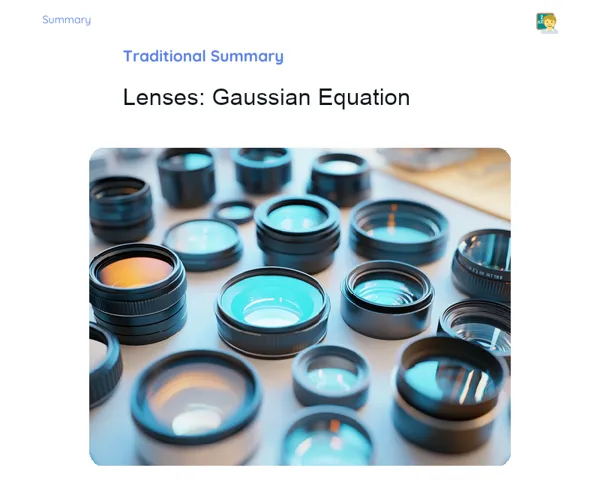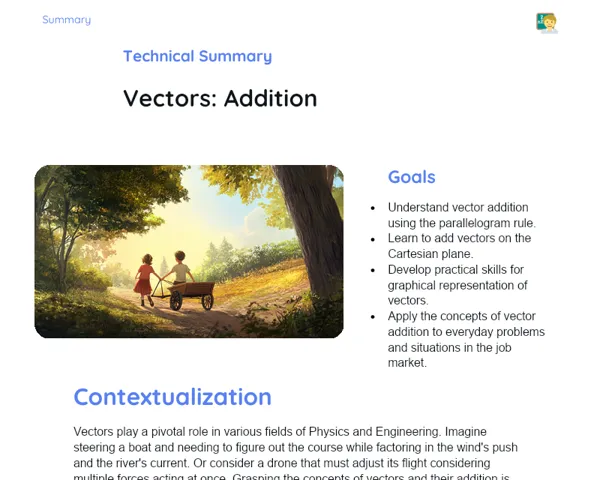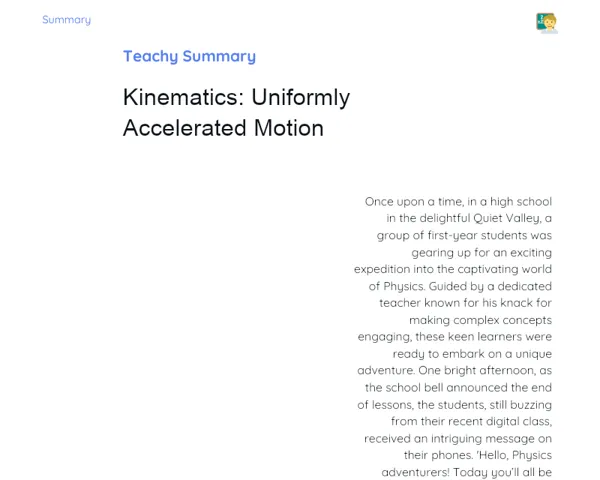Summary Tradisional | Magnetic Field: Wire
Contextualization
A magnetic field is essentially the space around a magnet where you can observe magnetic forces at work. When an electric current flows through a wire, it creates a magnetic field around that wire. This is a fundamental concept with diverse applications in today’s technology, ranging from electric motors and generators to transformers. Grasping how magnetic fields are produced by electric currents is crucial for understanding the functioning of various gadgets we use in our daily lives.
The phenomenon of generating a magnetic field around a wire carrying electric current is explained by the Biot-Savart Law. This law offers a mathematical framework to calculate the magnetic field based on the current moving through the wire and the distance from the point in question to the wire. Moreover, you can determine the direction of the magnetic field using the right-hand rule, which serves as a handy method for picturing how magnetic field lines coil around the wire. Familiarity with these ideas is key to tackling problems involving electric currents and magnetic fields, which will help in applying these principles practically.
To Remember!
Biot-Savart Law
The Biot-Savart Law is an essential equation in physics that describes how an electric current produces a magnetic field. It establishes a connection between the current flowing through a conductor and the magnetic field generated at a specific location. The formula for the Biot-Savart Law is B = (μ₀ / 4π) * ∫(I dl × r̂ / r²), where B represents the magnetic field, μ₀ is the magnetic permeability of free space, I is the current, dl is a small segment of the wire, r̂ is the unit vector pointing towards the point of interest, and r is the distance from the point of interest to the wire.
This law is vital as it helps accurately predict the strength and direction of the magnetic field across different current arrangements. This utility shines through in elaborate systems where the conductor's arrangement is complex, such as coils or circuits of irregular shapes. The law also aids in comprehending how factors like current intensity and distance to the wire influence the magnetic field.
By utilizing the Biot-Savart Law, one can compute the magnetic field around conductors of various shapes, from straight wires to circular loops. This is essential for crafting devices that hinge on magnetic fields, like electric motors and transformers. The law is also relevant in broader contexts, such as planetary and solar magnetic field studies.
-
The Biot-Savart Law delineates the relationship between electric current and the magnetic field.
-
The formula incorporates current, wire length, and the distance from the point of interest.
-
It is applicable in myriad current configurations and is fundamental to designing electromagnetic devices.
Magnetic Field of a Straight Wire
The magnetic field created around a straight wire that carries current can be calculated with a simplified version of the Biot-Savart Law. In this instance, the formula is B = (μ₀ * I) / (2π * r), where B denotes the magnetic field, μ₀ is the magnetic permeability of free space, I is the current flowing through the wire, and r is the distance from the point of interest to the wire.
This expression is derived from considering the cylindrical symmetry surrounding the wire, where the magnetic field remains uniform along concentric rings around the wire. This significantly eases calculations for long, straight wires, providing a swift method to determine the magnetic field strength at any point surrounding the wire.
Knowing how to determine the magnetic field of a straight wire is crucial for addressing practical issues in physics and engineering. For instance, when designing power lines, it’s critical to understand the strength of the magnetic field around the wires to guarantee the safety and efficacy of the system.
-
The formula B = (μ₀ * I) / (2π * r) is used to calculate the magnetic field of a straight wire.
-
The magnetic field is consistent along concentric circles around the wire.
-
These calculations are significant for practical applications like power transmission lines.
Right-Hand Rule
The right-hand rule is a handy method for determining the direction of the magnetic field surrounding a current-carrying wire. To apply it, place the thumb of your right hand in the direction of the electric current, and the remaining fingers will curl in line with the direction of the magnetic field lines encircling the wire.
This rule is incredibly beneficial in visualizing and comprehending how magnetic field lines orient around conductors. It can be extended to various current configurations, such as in coils and loops, helping predict the direction of the resultant magnetic field.
Accurate application of the right-hand rule is essential for resolving electromagnetism problems, especially those involving multiple conductors or analyzing magnetic fields in complex devices.
-
The right-hand rule aids in determining the direction of the magnetic field around a current-carrying wire.
-
Align your thumb with the current's direction; your fingers will show the magnetic field's direction.
-
It is critical for visualizing and addressing challenges related to magnetic fields.
Practical Applications
The magnetic field produced by a current-carrying wire has several practical applications in contemporary technology. One of the most common uses is in electric motors, where electric currents in coils generate magnetic fields that interact with magnets to create motion. This principle underpins the operation of nearly every electric motor, from small devices like coolers to large industrial machinery.
Another significant application is found in transformers, which harness magnetic fields to transfer electrical energy between different circuits. This is achieved through coils wrapped around a core made of magnetic material, where the current in one coil creates a magnetic field that induces a current in the other coil. This principle is vital for the efficient distribution of electrical energy in high-voltage networks.
Magnetic storage devices, like hard drives and magnetic tapes, also depend on the magnetic field generated by electric currents to record and retrieve data. In these devices, small currents adjust the orientation of tiny magnetic sections, making it possible to read back the data later.
-
Electric motors utilize magnetic fields created by currents to generate motion.
-
Transformers transfer electrical energy between circuits using magnetic fields.
-
Magnetic storage devices save and access data utilizing magnetic fields produced by currents.
Key Terms
-
Magnetic Field: The area around a magnet or electric current where magnetic forces are felt.
-
Electric Current: The flow of electric charges through a conductor.
-
Biot-Savart Law: The formula used to describe the magnetic field produced by an electric current.
-
Magnetic Permeability (μ₀): A physical constant that signifies how much a material can be magnetized.
-
Right-Hand Rule: A technique for determining the direction of the magnetic field around a current-carrying wire.
-
Electric Motor: A device that transforms electrical energy into motion through magnetic fields.
-
Transformer: A device that transfers electrical energy between circuits using magnetic fields.
-
Magnetic Storage Device: Technology that employs magnetic fields for recording and reading data.
Important Conclusions
The exploration of the magnetic field produced by current-carrying wires is fundamental to grasping numerous phenomena and technological devices. The Biot-Savart Law lays down the mathematical groundwork for calculating and predicting the strength and direction of magnetic fields, thus enabling the creation of practical applications like electric motors and transformers. The right-hand rule is a vital tool for visualizing the arrangement of magnetic field lines around electrical conductors.
Being adept at solving challenges related to calculating the magnetic field from current-carrying wires is a valuable asset in physics and engineering. The practical applications of this theory, like in magnetic storage devices and power transmission systems, showcase the significance of the knowledge gained. Understanding these principles is crucial for fostering innovation and technological advancements.
We encourage our students to dive deeper into the study of electromagnetism and explore various conductor configurations along with their applications. Continuing this exploration will enable a more in-depth understanding, empowering students to apply these principles in diverse and groundbreaking contexts.
Study Tips
-
Review the basic principles of magnetic fields and electric currents to solidify the foundational understanding.
-
Practice solving problems with the Biot-Savart Law and other related formulas to build confidence and precision in calculations.
-
Investigate additional resources, such as instructional videos and academic articles, to enhance visualization and comprehension of practical applications related to magnetic fields generated by electric currents.



